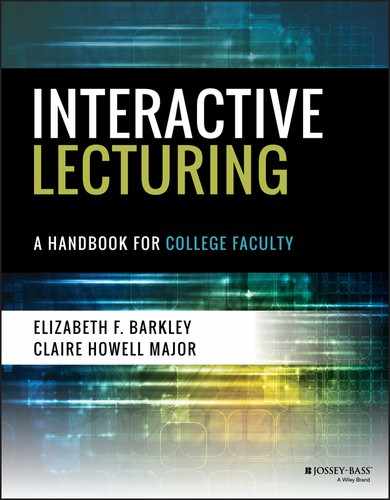ENGAGING LECTURE TIP 47
Echo Chamber
Echo Chamber means that when you take a question, you repeat or rephrase it out loud, which then can serve many purposes. First, it ensures that the other students in class know what question was asked. Especially in large classrooms, not everyone can hear the question, and without the question for context, the teacher's response probably doesn't mean much. Second, it avoids duplicate questions from students. When all students can hear the question, they are less likely to repeat each other. Third, the teacher gets to check his or her own understanding of the students' question before responding. Fourth, repeating the question ensures that the teacher clarifies its meaning for the rest of the class. This is especially useful if the question was long and rambling; rephrasing it can enable you to summarize it and share the general meaning. Fifth, repeating the question gives the teacher a moment to formulate a better response. Finally, repeating the question offers you the chance to alter it slightly, if necessary. In particular, if the question is not on point, you can gently redirect it so that it is appropriate and so that it contributes something positive to the class. (Note: if the question is not worthy of repeating, don't.)
After you have repeated the question, consider the following:
- Direct your answer to everyone. Although one student has asked the question, you are answering it for the whole class you are teaching. In addition, avoid the urge to walk closer to the student asking the question when you answer it because this can exclude the rest of the class. Instead face the full class when you offer a response.
- Get confirmation from the questioner. After responding, get feedback from the questioner as to whether your answer has adequately addressed the question. You can opt for a nonverbal signal, such as looking at the questioner and raising your eyebrows or shrugging your shoulders. You can also simply ask, “Does this address your question?” The response will likely be a nod or alternately a confused look. Respond accordingly.
- Promote a discussion. Sometimes when a question is open-ended, the best strategy is to get students involved in a discussion to encourage a variety of opinions.
- Admit if you don't know the answer. Simply tell students you will research the answer to the question and let them know what you learn, or alternately, ask for a volunteer to look it up.
- Take another question or conclude. At this point, you can either ask for additional questions, or if you are running out of time for the activity, restate your main point and conclude the session.
As Ford, McCullough, and Schutta (2012) suggest, paraphrasing a question is a skill in itself, and thinking about a response while you paraphrase one is an even greater skill. You get better with practice, however.
Example
Key References and Resources
- Ford, N., McCullough, M., & Schutta, N. T. (2012). Presentation patterns: Techniques for crafting better presentations. Boston, MA: Addison Wesley.
- Zaremba, A. J. (2011). Speaking professionally: Influence, power and responsibility at the podium. New York, NY: Routledge.
